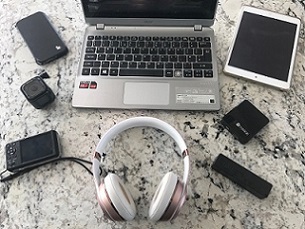 The last place you want a Lithium battery fire is in the confined space of a passenger aircraft
The last place you want a Lithium battery fire is in the confined space of a passenger aircraft
 A pilot with an AvSax Lithium battery fire mitigation bag
A pilot with an AvSax Lithium battery fire mitigation bag
 All these everyday personal electronic devices are powered by Lithium-ion batteries
All these everyday personal electronic devices are powered by Lithium-ion batteries
Lithium batteries may have made all our lives easier in the way they power our mobile phones and most other electronic devices … but they’ve made it far tougher for the emergency services to extinguish.
The reason is that Lithium battery fires burn totally differently to ordinary fires because they can keep flaring up again and again.
That means that once the original fire has been extinguished, the battery needs to be kept cool for hours afterwards.
That’s far easier said than done, especially in the confined space of an aircraft passenger cabin.
When Lithium batteries catch fire they go into what’s known as thermal runaway. This happens when one cell in a battery overheats it can produce enough heat – up to 900°C (1652°F) – to cause adjacent cells to overheat. This process takes just a split second and can cause a lithium battery fire to flare repeatedly even when it looks like the fire has been put out.
Lithium batteries can suddenly flare up again minutes or even hours later. In short, Lithium batteries burn hotter, faster and need far more water to fully put out than most other fires. Then there is always the danger that if they explode they will send sharp shards of metal flying in all directions.
Lithium battery fires can and do happen. Up to the start of June 2022 the Federal Aviation Administration (FAA) in the USA has recorded 373 aviation-related incidents involving lithium batteries carried as cargo or baggage since January 23, 2006.
These are just the events the FAA is aware of – there may well have been many more worldwide.
Airline companies can take no chances as a fire on a plane can have potentially catastrophic consequences with the fire giving out immense heat, flames and toxic fumes and that’s before the risk of the device exploding.
This is why more than 80 airline companies operating 15,373 aircraft worldwide now use lithium battery fire mitigation bags such as the award-winning AvSax.
AvSax thermal containment bags are designed to continually cool the overheating battery by adding water into the bag once the device has been put in there.
The water is absorbed into the sides of the bag which then expand and close in around the device, stifling any potential flare-up. The bag is made of military-grade material which means it can withstand the force of a blast even if the device explodes.
This use of liquid is recommended by the Civil Aviation Authority in the UK and many other fire containment bags don’t work this way.
In its guidance the CAA states: “Since the development of the International Civil Aviation Organization (ICAO) guidance on dealing with an in-flight battery fire, new products designed for use in response to lithium battery thermal runaway events have become available.
“Products which provide both a cooling and containment capability are typically more aligned to the existing ICAO guidance as when used they are filled with water or other non-flammable liquid to act as a cooling agent.
“After knocking down flames it could conceivably take just a couple of seconds for a personal electronic device to be placed inside a containment bag, allowing it to be moved to a place of safety. Passengers could then return to their seats, mitigating potential unrelated safety hazards such as injury in the case of severe turbulence. Equally, the effect on flight crew in carrying out their duties following an event on the flight deck would be minimised.”
AvSax have been used 33 times to deal with emergencies since the start of 2017 and every time they have been deployed the aircraft has been able to complete its journey safely with no need to divert or make an emergency landing. Diversions can be very costly to the airline company and can even run into hundreds of thousands of dollars.
AvSax managing director Richard Bailey said: “AvSax is the result of many years of development, drawing on experience from the production of a similar device designed for military applications such as suppressing explosions.
“Carrying an AvSax is a ‘one-size-fits-all’, easy-to-use method of dealing with an incident involving a portable electronic device that has caught or is showing signs of catching fire in the cabin or on the flight deck.”
Many air ambulance helicopters in the UK now also carry AvSax. More than 20 helicopters operated by specialist aerial emergency medical services company Babcock were equipped with AvSax following a detailed look into the possible risks posed by lithium-ion batteries on aircraft.
AvSax won the prestigious Queen’s Award for Enterprise in the UK in 2018, the highest accolade any company in the UK can receive.
For more information on AvSax please go to http://avsax.com/